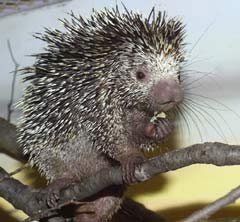
Brazilian porcupine(Coendou prehensilis)
Phylum —chordata
Class — mammalia
Order — rodentia
Family — erethizontidae
Genus – coendou
Appearance
The body is covered with short, thick spines which are whitish or yellowish in color, mixed with the darker hair, while the underside is grayish. The lips and nose are fleshy. The tail is prehensile, with the tip curling upward so as to get a better grip on tree branches. Its feet are reflective of their arboreal lifestyle, well-adapted for gripping branches, with four long-clawed toes on each.
This porcupine can grow to forty inches long (1 m), but half of that is tail. It weighs about nine pounds (4.1 kg). No spines are found on the tail, which is long (330–485 mm).
Habitat
The Brazilian porcupine is a porcupine found in Brazil, Argentina, Colombia, Venezuela, Guyana, Bolivia and Trinidad, with a single record from Ecuador.
Behavior
Brazilian porcupines are socially tolerant, especially when mates and food are abundant, but prefer small groups or a completely solitary lifestyle. These arboreal porcupines spend over 85% of their time in trees where they sleep, forage, and interact with other porcupines. High branches, forks, and hollow trunks are the preferred places for dens and for sleeping in during the day. They rarely venture to the ground where they mate, give birth, defecate, and intermittently forage. Being nocturnal, peak activity times for Brazilian porcupines are between 4 PM to 2 AM, and are dependent on the time of year.
Diet
In its natural habitat, Brazilian porcupines feed on the bark and cambium layer of some trees, buds, fruits, roots, stems, leaves, blossoms, unripened seeds, and agricultural crops like corn and bananas. Brazilian porcupines use their long claws to peel bark from trees and to open fruits. A favorite food source is the seeds of queen or cocos palms (Syagrus romanzoffiana).
Reproduction
Brazilian porcupines do not have a breeding season and can breed as early as 3 days after giving birth. Gestation lasts up to 203 days, after which one cub is born, which can almost immediately climb trees. Weaning occurs after 10 weeks.
In captivity
Brazilian porcupines have been known to live up to 27 years in captivity.
These porcupines quickly get used to humans and are quite unpretentious.
The enclosure should be spacious, with many branches and trees, so that the porcupine can climb all over its place.
In captivity, the diet of Brazilian porcupine diets are supplemented with corn, rat pellets, apples, dried grain, kale, oranges, sweet potato and Monkey Chow.
 Russian
Russian
 English
English


















